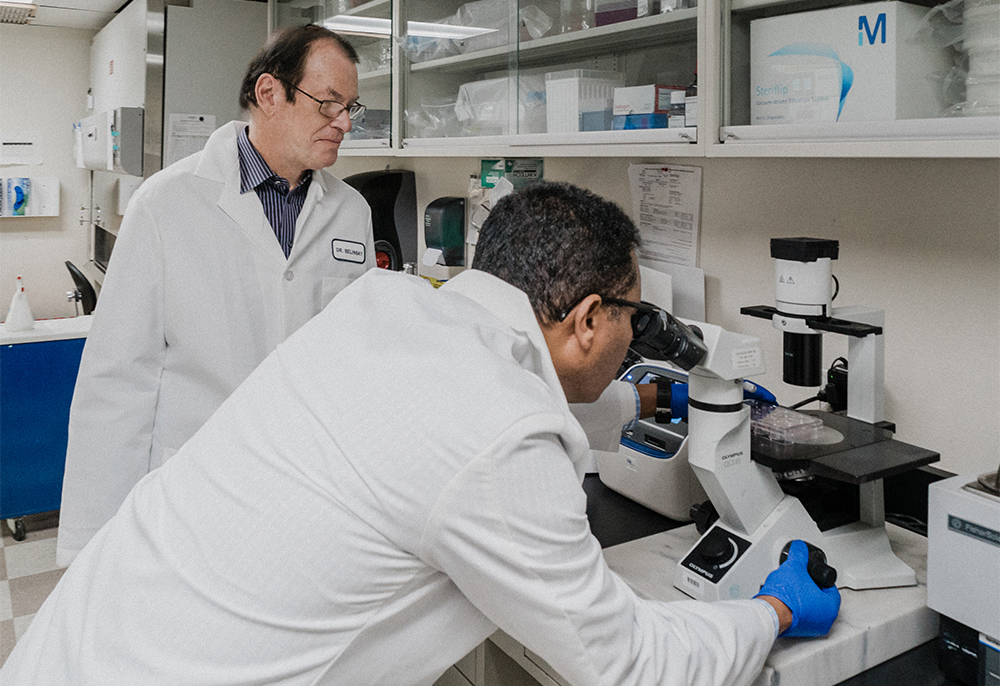Cutting-Edge Treatment for Lung Cancer
Researchers from Touro University and Lovelace Biomedical are Developing an Innovative Treatment for Lung Cancer

When it comes to cancer, none is more deadly than lung cancer—which kills roughly 125,000 Americans and 1.8 million worldwide each year. In fact, lung cancer accounts for 20 percent of annual cancer deaths in the U.S., taking more lives than breast, prostate and colon cancer combined. However, there may be new hope for patients with this deadly disease, thanks to an innovative treatment in development at the Lovelace Respiratory Research Institute, which is part of Touro University and New York Medical College.
Dr. Steven Belinsky is a renowned researcher who has spent his career improving early detection of lung cancer and is the recipient of the Alton Ochsner Award Relating Smoking and Health in recognition of his research on tobacco. Now the vice president for research and director of the Lung Cancer Program at Lovelace, working with aerosol expert Dr. Phil Kuehl, he has developed a patented dry powder that’s showing promise for shrinking lung cancers tumors.
The initial development and testing of the dry powder, which is inhaled, was funded by the NIH with a $4.6 million grant. During that process, the team achieved a 70 to 90 percent reduction in tumor growth in animals, which was particularly encouraging because the animals had multiple lung tumors.
The powder is a reformulation of 5-azacytidine (Vidaza), which successfully treats blood cancer, but is unstable and must be given by injection or IV over the course of eight days. “That means the patient has to come into the hospital for eight days in a row—which is cumbersome,” Dr. Belinsky explains. “Dry power drugs are already used to mitigate symptoms of COPD and asthma. This drug’s stability, direct delivery to the lungs and convenience for use at home all could lead to more effective treatment of lung cancer.”
Giving Cancer Patients New Hope for Longer Lives
Another benefit of the 5-azacytidine dry powder is that it not only treats the tumors in the lungs but it enters the circulation, where it can potentially affect disease that’s spread outside the lungs. This is crucial because, as Dr. Belinsky notes, “About 65 percent of lung cancer is diagnosed after it’s left the lungs—which is metastasis.” While it’s still very early and human trials are needed, Dr. Belinsky says he’s excited about “the potential impact it could have through extending survival for lung cancer patients.”
The next step in the process is to submit an Investigational New Drug (IND) application to the FDA, and pending approval, Dr. Belinsky hopes to start a Phase 1A trial geared toward safety in the summer of 2025. That trial will be conducted in partnership with the National Cancer Institute, and if the drug is shown to be well-tolerated and elicits a response in the subsequent Phase 1B, it could eventually move on to Phase 3 trials with support from a pharmaceutical company, which will finalize development and commercialization.
There is also tremendous potential for the variety of cancers it could be used to treat and for how it can be combined with other drugs. “This drug reverses methylation, a process that silences the function of hundreds of genes responsible for normal cell function in all different types of tumors, so there is potential for use in the treatment of other cancer such as colon and breast cancer,” Dr. Belinsky posits. It’s an exciting new frontier in cancer treatment—and one where Touro is proud to be leading the way.

